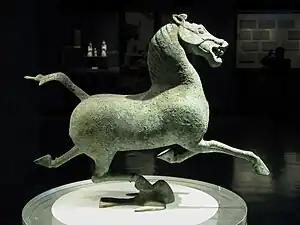

Tianma (天馬 Tiānmǎ, "heavenly horse") was a winged (perhaps metaphorically) flying horse in Chinese folklore. It was sometimes depicted with chimerical features such as dragon scales and was at times attributed the ability to sweat blood, possibly inspired by the parasite Parafilaria multipapillosa,[1] which infected the highly sought-after Ferghana horse (大宛馬), sometimes conflated with Tianma. Tianma, the flying horse, is clearly connected to Pegasus from the Western Han dynasty artwork[2] and in the Tang dynasty sources, as coming from Hellenized Central Asia.[3]
In the Western Zhou Empire, Tianma referred to a constellation.[4] Tianma is also associated with Emperor Wu of Han, an aficionado of the Central Asian horse,[5] and the famous poet Li Bo.[6] The bronze statue Gansu Flying Horse is a well-known example.
See also
References
- ↑ Schafer 1985, p. 295, note 19.
- ↑ "19.07.26.segalen".
- ↑ Lucas Christopoulos, Hellenes and Romans in ancient China Sino-Platonic papers. n.230, p38.
- ↑ Rutt, Richard (2002). The book of changes (Zhouyi): a Bronze Age document. Routledge. p. 331. ISBN 0-7007-1491-X.
- ↑ Kuwayama, George (1997). Chinese ceramics in colonial Mexico. University of Hawaii Press. p. 32. ISBN 0-87587-179-8.
- ↑ Wong, Laurence (2019). Thus Burst Hippocrene: Studies in the Olympian Imagination. Cambridge Scholars Publishing. p. 269. ISBN 9781527526150.
- Schafer, Edward H. (1985). The Golden Peaches of Samarkand. Berkeley: University of California Press. ISBN 978-0-520-05462-2.
- Weng, Wan-go; Yang Boda (1982). The Palace Museum: Peking. New York: Abrams.